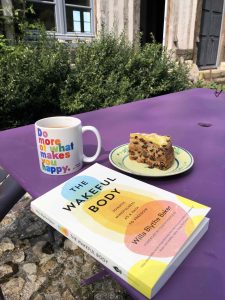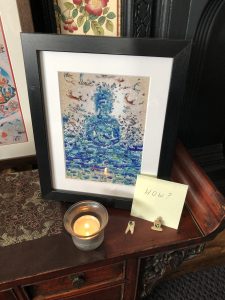
On my recent holiday, I read the excellent book “The Wakeful Body” by Willa Blythe Baker. As is often the case, the right books tend to jump off my bookshelf when I am selecting my holiday reading. This was a timely read having been exploring the three kayas teaching of Vajrayana Buddhism in some depth recently (you will have witnessed this on my blog): Baker’s whole book is structured around the three “bodies”. But maybe more critically for me, it was the perfect guide to help open up some experiential understanding as I sailed through a difficult period of Ngondro practice.
Baker’s book presents the acronym GROUND to take us on a tour of the three kayas:
G – grounding; establishing a relationship with the earth below; a trustworthy resource that can be known and its presence felt. Solid, stable, grounded.
R – relaxing; having a firm foundation we can then relax into that; slowing down into ease.
O – opening; curiosity and wonder, receptivity to what is unfolding – especially in the body and the energy within. A useful word prompt here is ‘grace’.
U – untangling; in the space that opens, letting the display play out,
N – nurturing; knowing and witnessing experience with a loving presence, like a parent watching their child play
D – dissolving; by simply being present, awareness expands and our sense of self as separate from experience dissolves. This is the meaning of non-self or interdependence, interbeing in the Buddhist teachings.
Grounding and Relaxing are associated with the nirmanakaya – the earth body or physical dimension of embodiment
Relaxing and Opening are on the level of the sambhogakaya – the energetic and experiential aspects of embodiment
Nurturing and Dissolving relate to the dharmakaya – the consciousness layer and the sense of being aware of our embodiment
Baker provides a series of practices to explore these three dimensions of experience through the six steps of GROUND. What I found helpful was keeping these prompts in mind as I surfed the turbulent waters of my Ngondro practice recently. As Baker reminds us:
“If mediation is doing its job, space opens within. In the space opened by practice, very memory and trauma will revisit us, every fear will surface. Our shadow will come out to play. This is not a sign of backsliding, it is a sign the work is beginning.”
As I was reading the book in Normandy, it also occurred to me that I could frame my practice experience on the three dimensions of the kayas:
The prescription of the teachings as the “form” of the practice, or nirmanakaya
The experience that unfolds trying to meet that exercise, the sambhogakaya
The awareness that knows the experience, the dharmakaya
If, as I mentioned last week, the healing power of the Vajrayana path is in the energy or subtle body dimension, “my” job becomes one of opening to and disentangling from the experience that is unfolding. The instructions (visualisation, mantra) are simply the prompt (or prod), awareness is the unconditional witness, and what is being communicated between the two is the healing or alchemical space (a bit like the relational between of psychotherapy). In her book, Baker offers a beautiful invitation – “to be a gracious host”.
 Back in the New Year, I remember my meditation mentor suggesting rather cryptically that we don’t meditate, that in fact meditation “does” us. I am starting to see and feel what this means. Rather than approaching my Ngondro with expectations, I am learning to sit and be open, curious, as to what is to come. It is like I sit on my meditation cushion “plugging in” like a phone to its charger: what is the energy I am to receive. I have placed a post-it note on my shrine – “how?”. If I find myself contracted up into my head, trying to work out “what” is happening or “why” it is, I see this note and settle back into the sambhogakaya of opening and untangling – “how is this playing out?”.
Back in the New Year, I remember my meditation mentor suggesting rather cryptically that we don’t meditate, that in fact meditation “does” us. I am starting to see and feel what this means. Rather than approaching my Ngondro with expectations, I am learning to sit and be open, curious, as to what is to come. It is like I sit on my meditation cushion “plugging in” like a phone to its charger: what is the energy I am to receive. I have placed a post-it note on my shrine – “how?”. If I find myself contracted up into my head, trying to work out “what” is happening or “why” it is, I see this note and settle back into the sambhogakaya of opening and untangling – “how is this playing out?”.
In her book, Baker refers to the meditation path as one of “waking down” rather than waking up. We in the West are already rather heady having lost our connection to the body and privileging intellect over feeling. Coupled with this, the spiritual journey has been recruited as a way to leave our body and ascend. “Waking down” emphases that enlightenment is in and through the body. Working with the subtle body asks for a going in and down, rather than up and out. To connect with the space within as continuous with the space without.
Making space a deliberate practice continues for me. As work gets busy, the temptation is to become speedy. I am looking for ways to create space – not just in my diary as free time, but also as a more pervasive attitude WHILE I am busy and doing. Again, shifting allegiance to awareness rather than the contents of that awareness.
In line with this, I am going to take a couple of weeks rest from blogging. Marking essays, and returning to my book draft need my attention. Until then, go well.
